The OnePlus 2 Review
by Brandon Chester on December 14, 2015 8:00 AM EST- Posted in
- Smartphones
- Mobile
- OnePlus
- OnePlus 2
GPU Performance
While general performance on the OnePlus 2 ends up being quite disappointing, when focusing on GPU performance we can hope for a much more appealing outcome as Adreno 430 continues to be one of the best GPUs you can get in a mobile device. While I don't expect there to be a large deviation from the performance of other Snapdragon 810 devices, given the unexpected difference with JavaScript and general CPU performance it's worth running the OnePlus 2 through our standard GPU benchmarks to confirm that everything is performing as expected. As always, we start off with 3DMark, followed by BaseMark X and GFXBench.
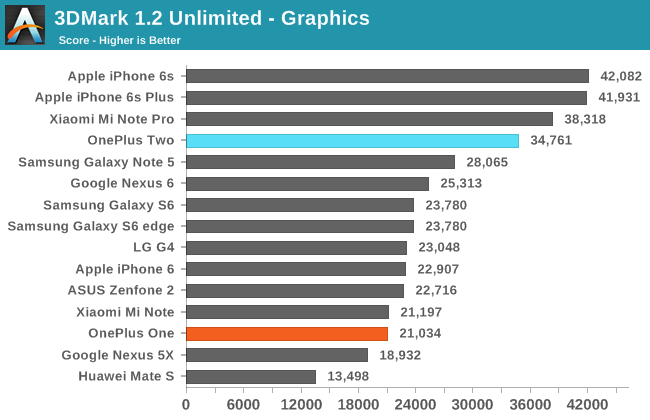

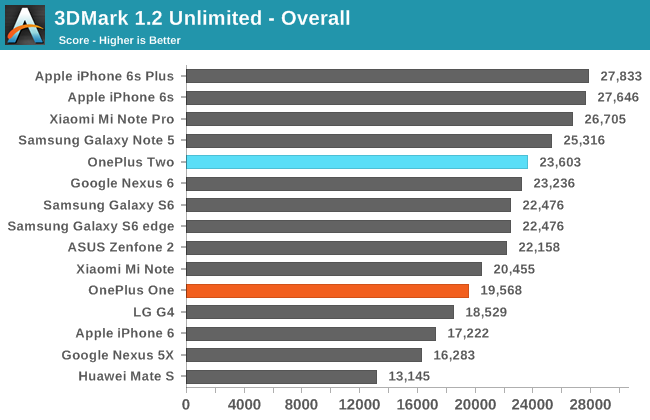
Snapdragon 810's Adreno 430 GPU is still very fast, and it achieves a very high score in 3DMark's graphics test. As usual, the physics test score basically just scales with frequency and number of cores in use, and with the big cores on the SoC throttling down we see a fairly low result there. I don't usually care much for the overall score, but since it's a weighted average we see the OnePlus 2 sitting near the Nexus 6, although in workloads that mainly stress the GPU you'll actually see a much larger gap between the two.
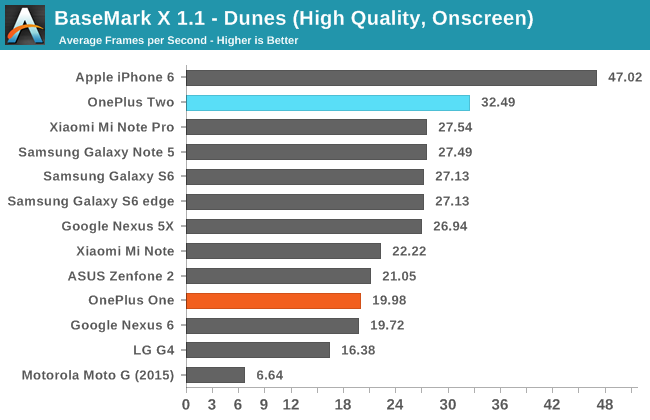
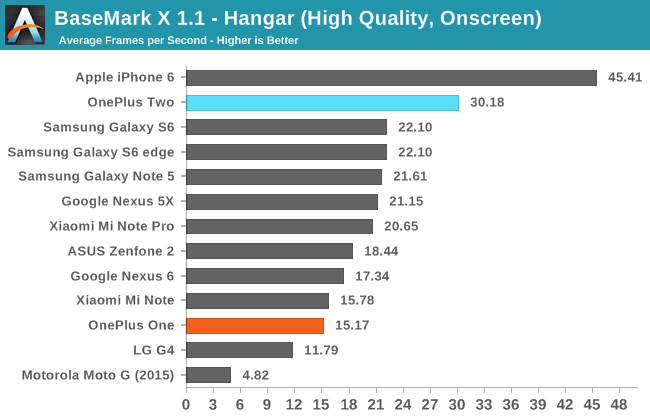
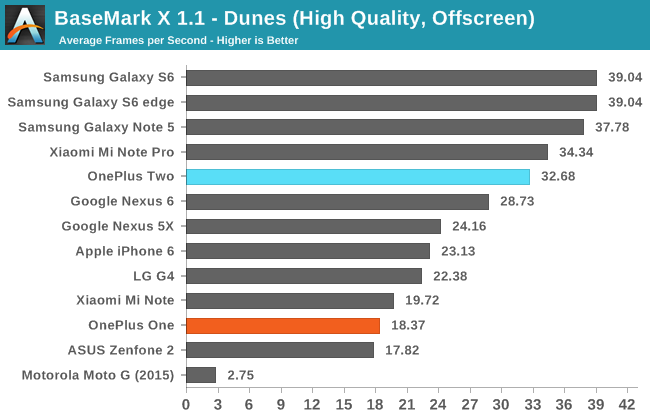
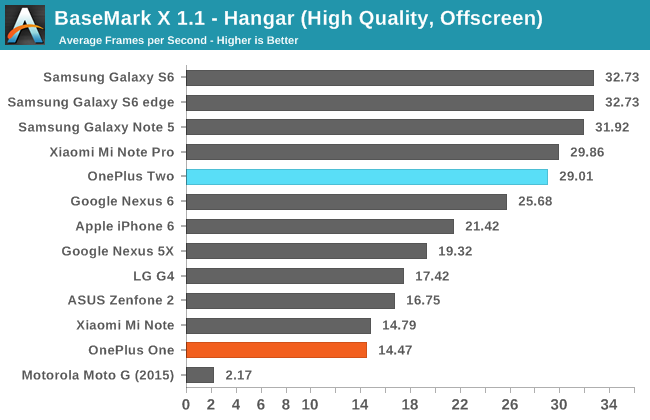
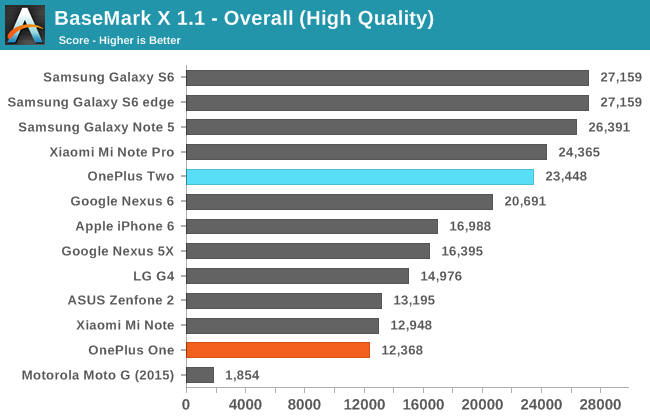
The OnePlus 2 performs very well in BaseMark X, tracking slightly behind the Mi Note Pro which we previously noted may have some level of additional optimizations at the driver level compared to the other Snapdragon 810 implementations. The improvement over the OnePlus One with its Adreno 330 GPU is quite large, with there being nearly a doubling in performance in the Hangar benchmark.

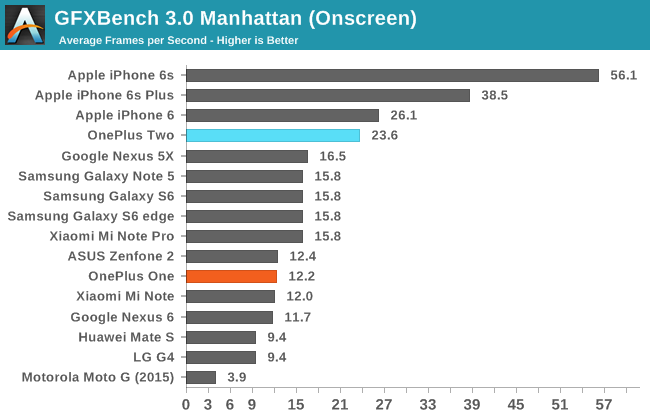

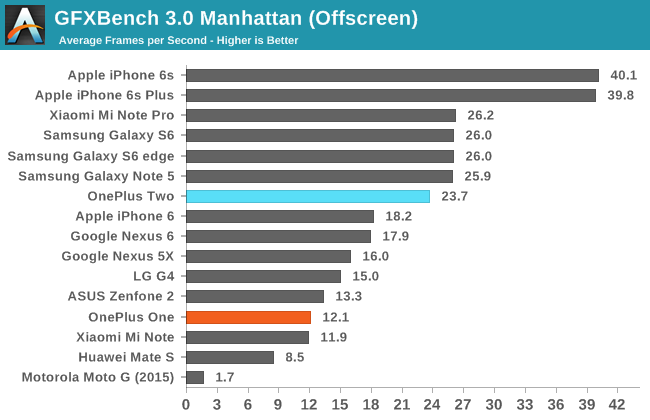
GFXBench's off screen performance results show that the OnePlus 2 is again a bit slower than the Mi Note Pro. In any case the performance is still very good and only really beaten by Samsung's Exynos 7420 devices, and the iPhone 6s. Since the display resolution is only 1080p you actually get better performance in games that run at native resolution than the Mi Note Pro and Galaxy Note5.
Adreno 430 has always been a good GPU, and in general the GPU performance of Snapdragon 808 and 810 hasn't really suffered in the same way the CPU performance has. At $400 the OnePlus 2 definitely gives you a lot of GPU power, and it's something that differentiates it from what's available at lower prices, and even other devices at the same price like the Nexus 5X.
NAND Performance
NAND performance is becoming a greater focus in mobile devices. To improve performance, vendors like Samsung and Apple have turned to solutions outside of the eMMC storage that is typically used in mobile devices. However, the vast majority of products still use eMMC NAND, and in some cases the performance of that NAND can be low enough to introduce noticeable performance issues when using a device. The OnePlus Two uses a Samsung CGND3R eMMC 5.0 NAND solution, which is the same as the one used in the Mi Note Pro.

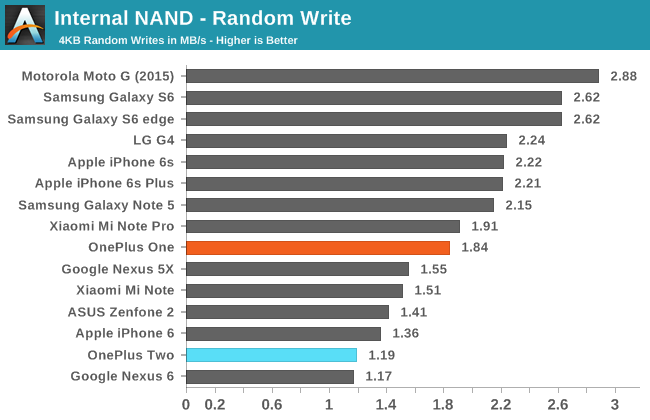
Random read speeds track closely with the Mi Note Pro. Random writes end up being quite a bit slower, and this occurs even with repeated tests so I'm not sure exactly what's causing it.
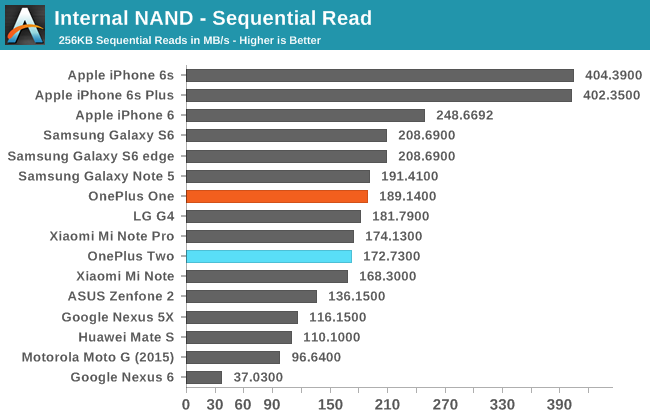
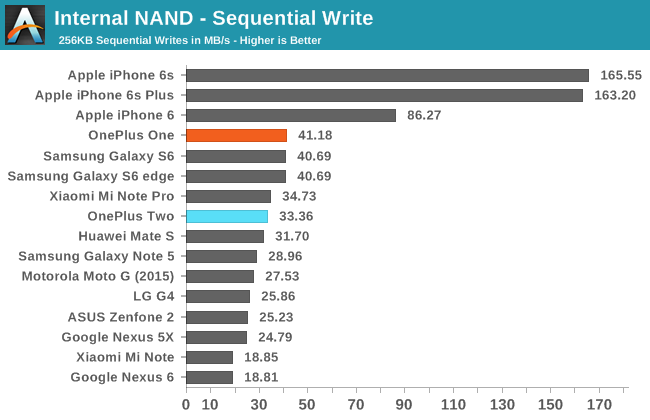
As expected, sequential read and write speeds track almost exactly with the Mi Note Pro. While the results are nothing ground-breaking, they're in line with what you get from an eMMC 5.0 NAND solution. In most cases another component of the phone will likely end up limiting performance before one runs into issues due to NAND speeds, but you won't see some of the benefits that you get with extremely fast NAND such as extremely quick app installation times, faster media transfers, etc.










132 Comments
View All Comments
lucam - Monday, December 14, 2015 - link
Hahaha...lol!!!cuex - Monday, December 14, 2015 - link
Is it possible for you to give review using a custom kernel that allow the usage of A57 Cores in normal usage? Would like to know whether it's really the "hesistant of using A57 Cores" is the cause of slow-down...danielfranklin - Tuesday, December 15, 2015 - link
Yes you can, i have and its very fast.In fact ive calibrated my display as well and im quite impressed with it now, the high contrast really comes alive.
Unfortunately with further hacking OnePlus havent properly released their source code and Devs are leaving it in droves.
Im quite happy with it (got it on special) but i cant help but think they have alienated the power users with the lack of code and alienated the normal users with the CPU performance and lack of calibration on the screen.
Personally i think they have kind of lost the plot.
adityarjun - Monday, December 14, 2015 - link
Umm, sorry to hijack this thread but I am in the market for a 5inch-ish android phone. My requirements are a good battery and camera and a decent enough display and lag free UI interaction. I don't game. My current phone is Moto G 2014. I am looking at the 5x, OnePlus X and Moto X 2014. I favor the last. Is it still a good buy?mcbhagav - Monday, December 14, 2015 - link
IMO, if you are dead set on 5" screen. You should get Nexus 5X ( i suggest 32 GB) out of above 3 contenders. Why not one Plus X? HW, SW, Radio are slower than 5X. Why not Moto X-14? smells already end of life.grayson_carr - Monday, December 14, 2015 - link
Wow, I was kind of shocked by the display analysis. I actually owned a OnePlus 2 for a short time way back in August and thought the display looked quite accurate. Granted, I was just using my eyes to compare it to my wife's iPhone 6 and my MacBook Pro and not a measurement tool, but it certainly seemed more accurate than the Nexus 6 and LG G4 which I also had at the time. But maybe I was just looking for oversaturation inaccuracies and not general innacuracies. Also, their website has this quote: "We focused on producing professional grade, true-to-life colors, avoiding over-saturation." (https://oneplus.net/2/technology) But Brandon also mentions that they keep changing the calibration profile with updates, so maybe the calibration has actually gotten worse since I owned it haha. I remember that happening with my OnePlus One... with one of the updates to that phone the color temperature went from like 6300K to 8000K.Bottom line, these little issues are why I ended up selling both my OnePlus One and OnePlus 2 after a very short time. I am a phone nerd and love to try different phones, but I think I'm done giving OnePlus chances to impress me only to be disappointed with the software and abundant other minor annoying issues that add up. I'm not sure how it is now, but when I owned the OnePlus 2 back in August the software was super buggy.
I currently own a Nexus 5X and I would highly recommend it over the OnePlus 2. Don't let the theoretically better specs of the OnePlus 2 fool you. I am having a vastly better end user experience with the 5X even though it doesn't match up spec wise.
zeeBomb - Tuesday, December 15, 2015 - link
Oh definitely. Very cautious move you have done there Grayson. To me, Oneplus has been slipping in terms of...what's the word...I guess presentation for what they have to offer.zeeBomb - Tuesday, December 15, 2015 - link
Take the One Plus X, another device that they had made this year. On paper the specs seem really good for the price you are getting it for... Then you realise it uses a modified 801AA chip plagued with bugs and sluggish graphical performance. I hope in the future Oneplus can fix these things so the user experience isn't such a hassle. At least the updates are quick enough.Another thing that seems to not be mentioned is the USB C cables. They were so cheap to buy, but little that we knew until the faithful Benson Leung came along is the resistor type was way incorrect, which makes charging the device pretty dangerous!
Granted to sum up Oneplus this year: You win some, you lose some.
sandy105 - Tuesday, December 15, 2015 - link
Where did you read about the 801AA and its graphics performance issues ? . I have the OPO and the 801 does well on most games , but i saw a oneplus X review where game performance was sun optimal and it got me thinking why did it happen.zeeBomb - Tuesday, December 15, 2015 - link
Oneplus forums say it all.